Float and Fly Techniques for Smallmouth Bass
A delicately presented hair jig can tempt cold-water smallmouth bass - and more.
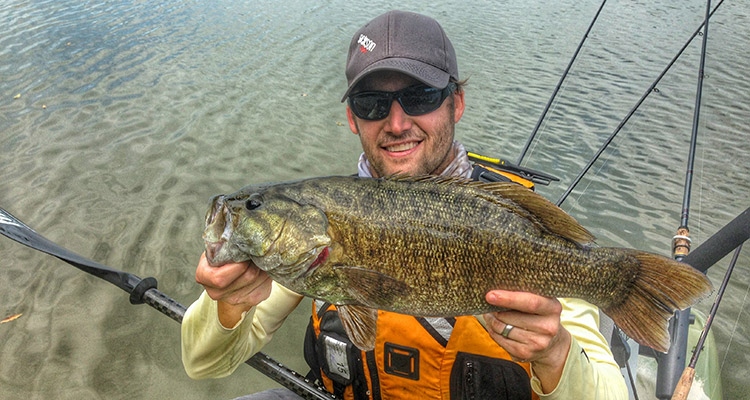
Back in the early 1980’s, when I first heard about the specialized technique known as “float and fly” fishing, most of the articles I read were geared toward southern smallmouth fisheries. One article in particular, authored by Charlie Nuckols and published a long time back in Bassmaster magazine, got me thinking about applying the technique in my tournament largemouth fishing during cold water or tough bites.
History of the Float and Fly
Charlie Nuckols is considered by many to be the father of the float-and-fly rig. Through online correspondence on a smallmouth fishing Internet discussion board, I was informed by some good ‘ole southern boys that Charlie did not actually invent the rig, but he did perfect it and was certainly a master at marketing it. Charlie drowned in a boating accident in 1996, just as his revolutionary bass system was gaining a following among southern smallmouth anglers. Today, Charlie’s brother Eddie Nuckols runs Bullet Lures, which remains the main source of the specialized lures and equipment used in the “Float-N-Fly” system.
The reality is that the float-and-fly rig had been around for many years prior to Charlie popularizing the technique. It started off as a way to fish small jigs and minnows to catch crappies in the winter. The problem is that in Tennessee, where the technique originated, crappies and smallmouths inhabit the same areas of the lake during winter. As a result, winter crappie fishermen would break off a lot of small jigs thanks to smallmouth bass – BIG smallmouth bass.
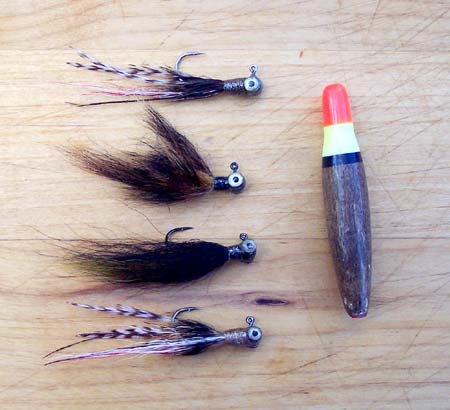
I first experimented with float-and-fly rigs early one spring. Like any new fishing technique, success brings confidence, but I didn’t find either in my early trials. It wasn’t until my brother-in-law joined me for a fishing trip that same year that I saw the true potential of the rig.
It was late November, and water temperatures were falling into the 40s. I took him to my rod-and-gun club pond because largemouth bass usually stack up there in very predictable spots in the fall. The fishing was fast, and in roughly an hour we blew through three-dozen live shiners while anchored up on a point bordering the main pond and a weedy back cove.
Afterward I switched to a suspending crankbait, but was met with limited success. John had been having great success using the float and fly for smallies where he lived in Ellsworth, Maine, and it didn’t take long for him to show me why. I was amazed that he was able to almost duplicate the catch rate we had with live bait, and after he landed a number of nice bass in very short order, I was begging him to set me up with a similar rig.
Where and When to Float-and-Fly for Smallies
• Flats or gravel bars adjacent to any of the above structures.
• Back coves that warm in early spring; woody cover is a bonus.
• In early spring, search out current bringing warmer water into a lake.
• Coves or shallow river systems that are too weedy to fish in the summer can be hot spots in the spring and late fall.
• In late fall, look for river smallmouth along sharp drop-offs in 6 to 20 feet of water.
This technique proved itself time and time again when the fishing conditions were tough, especially in cold water or when fishing extremely pressured bass. The rig really shines when it comes to catching quality smallmouth bass in early spring and late fall, but it is also an effective technique for largemouths, pickerel, crappies, bluegills and trout. I even caught a few winter holdover striped bass one cold day on a float-and-fly rig, just to prove it could be done.
Anatomy of the Float and Fly
Some of the larger mail-order fishing tackle companies offer float-and-fly kits, though I have opted to have a friend make my jigs, which guarantees me a good-quality hook. A good-quality fine-wire hook ensures a solid hookset on subtle coldwater bites. Many of the commercially available jigs use too heavy a hook, or if they are fine wire, they aren’t sufficient quality to tame large bass. Look for jigs with size 2/0 hooks and weights of 1/16 ounce and 1/8 ounce. If you tie your own, I recommend Owner or Gamakatsu jig hooks; both offer good-quality fine-wire hooks in these weights. Tying in some chenille on the hook shank ensures good absorption for your favorite scent, and don’t forget to make some with eyes; more times than not, jigs with eyes will out-fish those without.
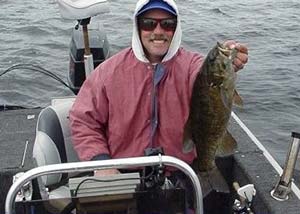
The southern experts are firm believers that craft hair breathes best, but I’ve had good luck with simple ties utilizing bucktail in natural colors. Those same southern experts suggest that on sunny days and in clear water, jigs should be light colors such as white, pink and baby blue. With clouds, wind or in stained water, white/chartreuse and smoke/chartreuse are their recommendations. I’ve always been a subscriber to the KISS principle (Keep It Simple, Stupid), and I’ve found simple ties with natural bucktail colors work just as well. White, for some reason, seems to excel under cloudy conditions. I like them tied so the bucktail is about twice the length of the hook, with an overall length around 2 ½ inches.
Choosing the Right Setup
Those same experts are also firm believers in using fixed bobbers with jigs set from 6 to 14 feet, which necessitates using lightweight noodle rods in 9- to 12-foot lengths. I don’t know about you, but at the time I was experimenting with this rig, the last thing I wanted in my tournament bass rig was a 12-foot noodle rod – talk about an accident ready to happen! Luckily for me, my friend John introduced me to his version of the rig, which utilizes a slip bobber and can be fished on a standard-length rod. In my many years of use, the only disadvantage I have found is that when fishing depths beyond 6 feet on windy days, it sometimes takes some work to get the jig to pull the line through the bobber. Staying with a heavier 1/8-ounce jig usually solves that problem.
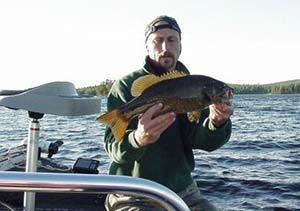
I never experimented with a fixed bobber and noodle rod; the thought of trying to cast 14 feet of line hanging beyond a 12-foot rod just never appealed to me. For those who might be braver than me, however, I’ll describe those traditional southern rigs for comparison.
From the rod, 6- to 8-pound-test braided line is typically attached to a three-way swivel with a uni knot. From the swivel, attach a length of light 6- to 8-pound-test fluorocarbon fishing line. Usually this dropper is 9 to 12 feet in length. The third swivel loop is where you attach the bobber. Learning the intricacies of casting this fixed-bobber setup is important, and the key, obviously, is a long noodle rod. When you make your backswing, you have to make sure that the lure hits the water behind you and the rod is fully loaded before you cast.
Fishing the traditional setup and rigs certainly works for those who are willing to take the time to master it, but if you’re like me and you’d prefer to just break out the rigs and fish them on your standard spinning or even conventional rods, then the slip bobbers might be the thing for you.
If you want to go slip bobber, a medium light 6 ½- to 7-foot rod is all you need. Stay away from fast-action rods that flex mostly in the tip; instead, look for a more parabolic bend and a rig rated for 1/8 to 3/8 ounces and 6- to 15-pound-test line. My rod of choice would typically be spooled with 10-pound-test Fireline, so when it’s time to break out this rig, I only need add a 12-foot leader of 6- to 8-pound-test monofilament or fluorocarbon.
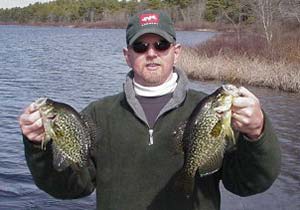
There are a number of different style bobber stops available, and I’ve tried them all with varying success. You should experiment with a couple styles to see what works best for you. I’ve found that the yarn stops work better when fishing deeper, as they don’t walk up and down the line excessively when reeled in past the rod tip. For bobbers, I’m partial to the 4 3/8-inch Thill Center Slider balsa slip bobbers. A small package of glass beads will round out the terminal tackle. To rig, run the mono through the bobber stop and slide it up your line. Run the line through a small glass bead, then through the slip bobber. Then tie on your jig, have a bottle of scent handy, and you’re ready to go.
How to Fish the Float and Fly
Set the bobber stop to suspend the jig just off the bottom, at the top of the weed bed, or at the depth you think fish are suspended. Put a couple drops of your favorite scent on the jig and let her fly! The best action is no action at all; just allow the waves to move the jig up and down in tiny increments that cause the hair and feathers to twitch and pulsate. In the flattest conditions, I’ll work the bobber ever so slowly back to the boat with slight rod twitches, letting the fly sit for minutes at a time between movements. In a slight chop, move the float only occasionally to change position.
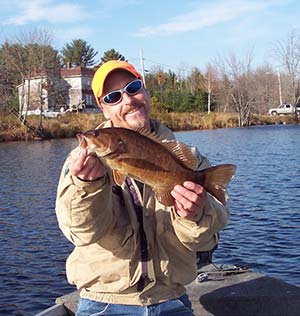
Patience is the name of the game, especially in cold water, which is when this rig works best. Let the rig sit for a minute or so, then move it only a foot or two using subtle movements of the rod tip to give the jig a little action. You can repeat this until you are out of the strike zone, but I can’t emphasize enough the importance of going extremely slow.
Stay focused on the bobber at all times. Some strikes will be easy to detect, with the bobber being pulled completely under the surface, but that’s not the norm. The bobber might simply move differently or suddenly lie flat on the water, indicating that a fish has taken the weight of the jig off the bobber. Make certain that the drag on the reel is relatively loose for the light monofilament, especially if you are using a low-stretch main line, and set the hook by raising the rod straight up.
Assuming you are using sharp fine-wire hooks, that is all that is required to set the hook. There’s no need for that “summertime, jig-n-pig fishing, cross your eyes” hookset here. Also remember that any time you are fishing with light line, it’s important to retie often. After a few fish, retie and adjust the depth of the jig.
Don’t think of this rig as being suitable for small buck bass alone. I’ve caught countless bass over 4 pounds on this rig, with many smallmouth and largemouth bass to 6 pounds. It works extremely well for cold-water largemouth bass, pickerel, perch and crappies. In fact, this has become the go-to rig for our traditional early-spring crappie fry, which we usually schedule a short time after ice-out, when a few weeks of warming guarantees crappies in the shallow coves. One particular southeastern Massachusetts river system is so thick with weeds that you could walk across them in the summertime, but that same skinny water in early spring offers warmer water and an abundance of crappies, bass and pickerel hanging just above the emerging weeds.
Whether you want to kick off your season early or extend it well into the fall, I can’t think of a more versatile rig to fish for a multitude of species. When the water temperatures drop in the fall or rise in the spring into the upper 40s, it’s prime time to break out the float and fly. The fact that it requires a slow, deliberate presentation is a natural fit for the bulky clothing required to maintain warmth during these colder months. Whether you opt for the traditional setup or a slip bobber approach, this finesse technique is a guaranteed winner when the water gets cold and the bite gets tough.
For me, one of the less obvious rewards to mastering this technique is that it instantly connects me to my youth, bringing back those wonderful memories of waiting in anticipation for my bobber to go down. It’s a relaxing way to start or finish your season, watching patiently for your bobber to telegraph a subtle hit, and wondering as you set the hook whether it’s a crappie or a nice bass that has taken your jig.
Related Content
3 on “Float and Fly Techniques for Smallmouth Bass”
-
Harold Perry I will try this in a couple mo. at lake ERIE around middle Island on the Canada side . Thank you. If you have any info drop me a line .
-
G wilson Great article.
Had good luck with simularh technic with fly rod on Littel ossipe lake in Maine.
The day before I was casting Sinkos and doing well but was getting board and wanted to switch it up. So I swiched to a 6 weight fly rod and started casting several bass bugs with less luck then the day before. I finally thru try and failur landed on woolly bugger patterns, darker worked better with a thingamabobber fishing them in the same way as described above. Then the game was on for the rest of the day. -
Ntau yang This does help a little but doesn’t answer my question of how many times you need to twitch the bobber
Leave a Reply